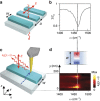Boron nitride nanoresonators for phonon-enhanced molecular vibrational spectroscopy at the strong coupling limit
- PMID: 30839544
- PMCID: PMC6060053
- DOI: 10.1038/lsa.2017.172
Boron nitride nanoresonators for phonon-enhanced molecular vibrational spectroscopy at the strong coupling limit
Abstract
Enhanced light-matter interactions are the basis of surface-enhanced infrared absorption (SEIRA) spectroscopy, and conventionally rely on plasmonic materials and their capability to focus light to nanoscale spot sizes. Phonon polariton nanoresonators made of polar crystals could represent an interesting alternative, since they exhibit large quality factors, which go far beyond those of their plasmonic counterparts. The recent emergence of van der Waals crystals enables the fabrication of high-quality nanophotonic resonators based on phonon polaritons, as reported for the prototypical infrared-phononic material hexagonal boron nitride (h-BN). In this work we use, for the first time, phonon-polariton-resonant h-BN ribbons for SEIRA spectroscopy of small amounts of organic molecules in Fourier transform infrared spectroscopy. Strikingly, the interaction between phonon polaritons and molecular vibrations reaches experimentally the onset of the strong coupling regime, while numerical simulations predict that vibrational strong coupling can be fully achieved. Phonon polariton nanoresonators thus could become a viable platform for sensing, local control of chemical reactivity and infrared quantum cavity optics experiments.
Keywords: SEIRA; boron nitride; phonon polaritons; strong coupling; surface-enhanced infrared absorption spectroscopy.
Conflict of interest statement
R Hillenbrand is co-founder of Neaspec GmbH, a company producing scattering-type scanning near-field optical microscope systems, such as the one used in this study. The other authors declare no conflict of interests.
Figures





References
-
- Griffiths PR, de Haseth JA. Fourier Transform Infrared Spectrometry. Hoboken, NJ, USA: Wiley; 2007.
-
- Hartstein A, Kirtley JR, Tsang JC. Enhancement of the infrared absorption from molecular monolayers with thin metal overlayers. Phys Rev Lett 1980; 45: 201–204.
-
- Osawa M. Surface-enhanced infrared absorption. In: Kawata S, editor. Near-Field Optics and Surface Plasmon Polaritons. Berlin, Heidelberg, Germany: Springer; 2001, pp163–187.
-
- Neubrech F, Huck C, Weber K, Pucci A, Giessen H. Surface-enhanced infrared spectroscopy using resonant nanoantennas. Chem Rev 2017; 117: 5110–5145. - PubMed
-
- Aizpurua J, Taubner T, García de Abajo FJ, Brehm M, Hillenbrand R. Substrate-enhanced infrared near-field spectroscopy. Opt Express 2008; 16: 1529–1545. - PubMed
LinkOut - more resources
Full Text Sources
Other Literature Sources

